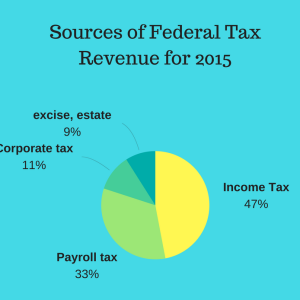Thursday, March 16 was a bitter day for many people after Trump announced his proposed 2018 budget that included billions of dollars of government agency cutbacks in order to bolster an already extensive allowance given to military and homeland security.
So what does this mean for Americans? First, it is worth explaining where our taxes go w hich pay for many of these services and programs that the United States needs in order to continue being the biggest competitor out there. Federal tax revenue comes from three main sources of taxes: individual income taxes, payroll taxes and corporate income taxes.
hich pay for many of these services and programs that the United States needs in order to continue being the biggest competitor out there. Federal tax revenue comes from three main sources of taxes: individual income taxes, payroll taxes and corporate income taxes.
Individual income taxes are taxes that anyone who is making an income or profit pays. These taxes account for 47 percent of the federal tax revenue. 33 percent comes from payroll taxes which are taxes imposed on your wages and usually go towards social security and Medicare. 11 percent of the federal tax revenue comes from corporate income taxes which businesses pay.
To break it down even further, 17 cents out of every income tax dollar goes to programs such as supporting agriculture, commerce, transportation, scientific research and natural disasters as well as the environment, educational programs and even law enforcement. These important programs are called non-defense discretionary programs.
Almost one-quarter of our budget goes to national defense, which is of course greatly needed but you can see the disparity between these two numbers. Many programs, research and technology advancement is in that 17 percent, which just seems so minuscule compared to almost one-quarter of the budget being for military purposes. So why should more money go towards the national defense budget and who will it affect?
The New York Times released a comprehensive list of where and who this proposed budget-change will hurt. With Trump’s new plan of adding to the military and homeland security budget, the U.S. will see a 1.2 percent cut in discretionary spending when it was already at an all-time low.
The biggest cutback will be to the Environmental Protection Agency, which is responsible for protecting human health and the environment. Two pretty massive and important roles that should not and honestly cannot be cut even more than it is now. But the EPA will see one of the biggest cut backs with a 31 percent change. The baseline budget in 2017 was $8.2 billion and now for 2018, it is proposed to be only $5.7 billion. If this happens, the cut would halt many integral programs needed to maintain air quality, climate change research and keeping our planet healthy. Ultimately, if this plan goes through, 3,200 positions in the EPA will be lost due to the massive cutback. Another major hit to the EPA is Trump’s proposed slash of the Clean Power Plan, which was set in place to ensure power plants were emitting as little green house gasses as they could. If greenhouse gasses are unregulated, the temperature of the earth will increase at an alarming rate which will cause mass extinctions of animals and humans alike.
Trump’s plan to cut the budgets of 14 organizations has left people wondering where this extra money will go. A proposed $54 billion increase in military spending will be implemented for increases in troops, aircrafts, such as fighter jets, naval power and the further development of nuclear weapons. While a strong military is greatly beneficial to the success of a country, the United States military is still the biggest force without the $54 billion increase.
Gordon Adams, former senior White House national security budget officer, said in an interview with New York Times, “Unless you decide you’re going to war and going to war soon, nobody keeps a large military.”
An ever-growing military and defunding of programs such as the Clean Power Act, work-study for college students and cuts to FEMA prove that Trump does not understand the ramifications associated with these major cutbacks. A country is nothing without its people and the United States citizens will feel the majority of these effects since these programs targeted the improvement of daily and long term life.



